 |
| 15 sec, 18mm, ISO 400, f/4.5 |
My learn-by-doing astronomy and astrophotography blog and observing journal
Tuesday, April 30, 2013
Corvus the Crow and Spica's Spanker
Corvus the Crow, with pointer stars toward Spica. Part of the shape resembles a kind of sail called a spanker, which gives the 4-star asterism the name "Spica's Spanker."
Thursday, April 25, 2013
Full moon rising between apartment buildings
Thanks to the couple in that apartment for not freaking out at the guy with the camera 50 feet from their kitchen window :)
I was at the gym when the moonrise began at twilight tonight, but I saw it hovering over the intramural fields on the drive home. I went inside to get our dog Katie and took her outside to scout a spot to set up my tripod. My plan was to get a picture of the moon rising over the apartments next door. While I was walking around the courtyard I saw a big yellow moon looming low between a the buildings. It was like the Stonehenge of equal opportunity housing!
I was at the gym when the moonrise began at twilight tonight, but I saw it hovering over the intramural fields on the drive home. I went inside to get our dog Katie and took her outside to scout a spot to set up my tripod. My plan was to get a picture of the moon rising over the apartments next door. While I was walking around the courtyard I saw a big yellow moon looming low between a the buildings. It was like the Stonehenge of equal opportunity housing!
 |
| Apartments at ISO 1600, 1/25s; Moon at ISO 100, 1/50s |
Messing about with the Full Pink Moon (99%) and Spica
The Full Pink Moon, named after a type of flower called grass pink, will not actually be pink as it rises tomorrow 12 minutes after sunset. In fact, it will probably be orange - similar to this twilight moonrise in February. Deferring to the alternate name, the Full Sprouting Grass Moon, might alleviate some of the confusion.
Tonight, the moon caught my attention through my bedroom window. I noticed a strange glare caused by the window pane that created 6 reflections that looked like they were orbiting the moon.
When I went outside to get a good look, I noticed Spica to the upper right of the moon a couple degrees away. The star showed a subtle blue color. Spica is actually a blue giant star 260 light years away. It's 15th brightest in our night sky. Tonight the moon will actually occult (pass in front of) Spica in parts of South America.
Taken from my bedroom window, this tree silhouette in front of the moon looks like a cracked plate.
Tonight, the moon caught my attention through my bedroom window. I noticed a strange glare caused by the window pane that created 6 reflections that looked like they were orbiting the moon.
 |
| 75mm, ISO 200, 1/5 sec |
When I went outside to get a good look, I noticed Spica to the upper right of the moon a couple degrees away. The star showed a subtle blue color. Spica is actually a blue giant star 260 light years away. It's 15th brightest in our night sky. Tonight the moon will actually occult (pass in front of) Spica in parts of South America.
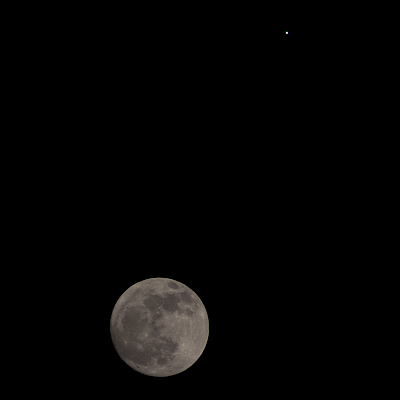 |
| Composite image, stacked moon each 1/1000 sec, f/5.6, ISO 100, 300mm |
Taken from my bedroom window, this tree silhouette in front of the moon looks like a cracked plate.
 |
| 300mm, 1/200 sec, ISO 200 |
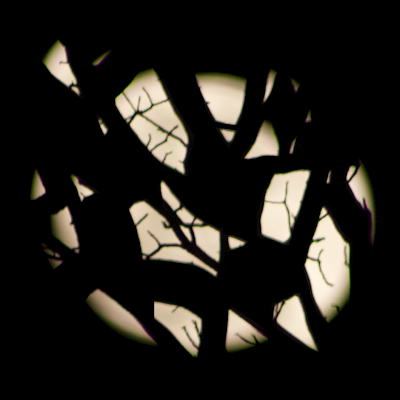 |
| Photoshop emphasizing the cracked dinner plate look of a tree silhouette in front of the moon |
 |
| 42 stacked frames, each 1/1000 sec, f/5.6, ISO 100, 300mm |
Tuesday, April 23, 2013
Tonight's 90 percent waxing gibbous
I wanted to take advantage of the clear sky, even though the moon is dominating and drowning out everything else around it tonight. Here is one artsy/clever moon shot through a pine tree, and a stack of 100 frames trying to bring out as much detail as possible in a realistic way. I think I'm reaching the upper limit of the resolution I can get on an 8 MP camera.
There's a faint stacking halo to the right of the moon, as if one frame got mis-aligned and spewed off to the side. So I guess it wouldn't be correct to say that this is the MOST detailed I could be at 8 megapixels, but for right now it is.
Just to say I tried, here's a re-stack of the 90% moon with only 58 of the 100 frames. Like magic, no alignment halo! I wish I knew how to fix this without just dumping frames, but in any case, here is a much tighter result (original color):
 |
| 100 frames stacked, each at 300mm, f/5.6, ISO 100, 1/1000 sec |
 |
| 300mm, f/5.6, ISO 100, 1 sec |
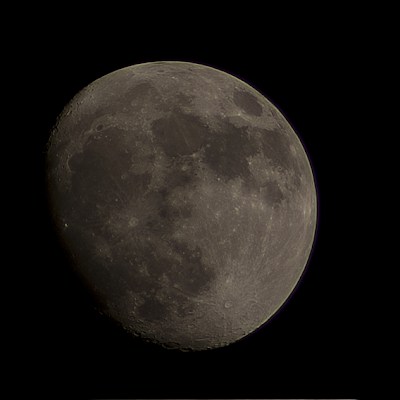 |
| 58 frames stacked, each at 300mm, f/5.6, ISO 100, 1/1000 sec |
Monday, April 22, 2013
Composite Moon Phases
I finally completed my set of moon phase photos! Obviously these are just the named categorical phases, because the shadow on the moon is constantly changing by tiny percentages all the time.
It was a fun project to work on! Each image is a stack of at least 20 frames to clean up the noise. I took the photos between February 25, 2013 and April 14, 2013. I left the colors a little different because I used different camera settings for each one and took the images at slightly different times of night (and early, early morning).
I'm really pleased with the result! It's my own little moon collection. Previously, I realized I only had waxing phases in my collection. I must say, the waning phases are quite cool and different. I guess the waning phases aren't as popular because you have to stay up later and later to get them, or get up right before sunrise to get a good waning crescent.
It was a fun project to work on! Each image is a stack of at least 20 frames to clean up the noise. I took the photos between February 25, 2013 and April 14, 2013. I left the colors a little different because I used different camera settings for each one and took the images at slightly different times of night (and early, early morning).
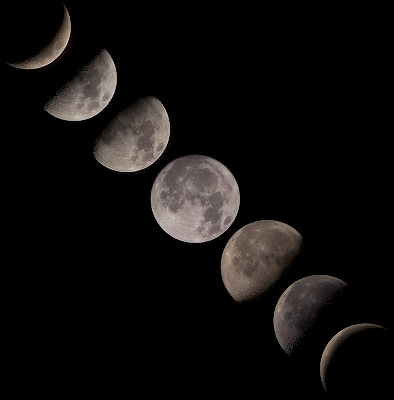 |
| Variety of settings, all at 300mm, f/5.6 with Canon Rebel XT stacked in Registax |
I'm really pleased with the result! It's my own little moon collection. Previously, I realized I only had waxing phases in my collection. I must say, the waning phases are quite cool and different. I guess the waning phases aren't as popular because you have to stay up later and later to get them, or get up right before sunrise to get a good waning crescent.
Lyrid Meteor Recap: 2 Sightings but Nothing in the Can
Last night I woke up at 2:30am to take the dog out. I planned ahead for the Lyrid Meteor Shower by setting my tripod and camera out before going to bed, and making sure my batteries were charged up.
I read that the Lyrid shower isn't typically as dramatic as other meteor showers, however I figured it was worth a peek since I was up and it was clear.
When I took my dog out, I did a quick scan of the darkest part of the sky and immediately saw a meteor streak from East to West (facing South). The 83% moon was still peeking over the top of the apartment building and producing a lot of sky glow. After picking up Katie's poops I went back in side, optimistic that the meteor shower would be as prolific as the Geminids this past winter.
 |
| Rebel XT: 18mm, 20 sec, ISO 1600, f/4.5 |
 |
| Rebel XT: 18mm, 20 sec, ISO 1600, f/4.5 |
 |
| PowerShot A3100 IS: 6.2mm, 15 sec, ISO 1600, f/2.7 |
 |
| Rebel XT: 18mm, 20 sec, ISO 1600, f/4.5 |
While my cameras were running, I spotted one more meteor in the general area where I thought it would make it into frame - alas, either it was just out of frame or it was too brief to show up on the sensor. Visually, I was able to observe 2 pretty good Lyrid meteors, but I was left with nothing on "film" a.k.a. nothing in the can.
While I was out, I did become more familiar with the late spring sky, which will soon become the early summer sky. I spotted Hercules, and of course the Summer Triangle. I also took a picture of Arcturus, Spica, and Saturn in a triangle next to the glow of the moon just behind the apartments.
Sunday, April 14, 2013
Crescent moon with Jupiter tonight, April 14, 2013
It was cloudy all day here in Bowling Green, Ohio. At dusk, I saw the clouds break a bit, but a thin layer of haze remained into the night. Photographed from my apartment complex courtyard at 10:00pm ET, the crescent moon created a ghostly smile through the clouds. In this single exposure, Jupiter is a small point to the lower right.
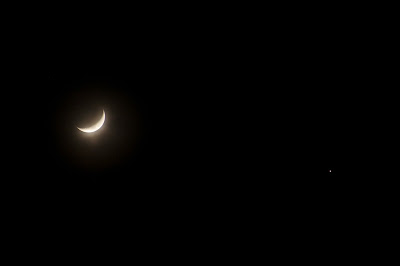 |
| Single exposure at ISO 100, 210mm, 1/2 sec, f/5.0 |
I also made a stack of the crescent moon to round out my stacked lunar phases collection. Before, I only had a single exposure of this phase of the moon. Now I should have enough for a composite picture of the main phases: crescent, quarter, gibbous, full, gibbous, quarter, crescent, new.
I also have to say, I'm super impressed with the Registax software! I took these 38 subs through a haze of thin clouds, and after stacking you would think the sky was completely clear tonight!! Impressive!
Comet PanSTARRS buzzes the Andromeda Galaxy
Last month I posted my plan to photograph C/2011 L4 (PanSTARRS) as it approached the Andromeda Galaxy (M31). I was successful, but never got around to blogging about it, so here goes! On April 2, 2013 I went to Slippery Elm Trail at dusk to wait until the comet and galaxy were visible low in the NW sky.
I had all but given up on Andromeda for the season, because the view to the west from my apartment is blocked below 40º or so. This far into Spring, Andromeda is well behind the building by sunset, and so low in the sky by the time it gets dark that taking detailed deep sky images with my camera probably wouldn't yield anything beyond a fuzzy blob. However, paired with a comet, a fuzzy blob would be a welcome target!
I used bright stars in Cassiopeia and Andromeda to star hop to the approximate location. Once I knew I was in the area, I used the same technique from the last time I spotted Andromeda or PanSTARRS - and that is to take 10 second exposures and see what blobs appear. Then, once you have the images framed well, take exposures more appropriate for stacking (in my case, 1.6 sec at 190mm).
Here is a wide field shot to show just how low M31 ended up at the end of my night. With all the atmospheric distortion and light pollution, it's a wonder I was able to see the darn thing!
I had all but given up on Andromeda for the season, because the view to the west from my apartment is blocked below 40º or so. This far into Spring, Andromeda is well behind the building by sunset, and so low in the sky by the time it gets dark that taking detailed deep sky images with my camera probably wouldn't yield anything beyond a fuzzy blob. However, paired with a comet, a fuzzy blob would be a welcome target!
 |
| 180 subs, 30 dark, 30 bias; subs at 1.6 sec, ISO 1600, f/5.0, 190mm |
I used bright stars in Cassiopeia and Andromeda to star hop to the approximate location. Once I knew I was in the area, I used the same technique from the last time I spotted Andromeda or PanSTARRS - and that is to take 10 second exposures and see what blobs appear. Then, once you have the images framed well, take exposures more appropriate for stacking (in my case, 1.6 sec at 190mm).
 |
| One of my "finder frames" to help me zero in on my targets, 10 sec, ISO 1600, 190mm |
Here is a wide field shot to show just how low M31 ended up at the end of my night. With all the atmospheric distortion and light pollution, it's a wonder I was able to see the darn thing!
 |
| Background image is a single exposure at ISO 1600, 13 sec, 18mm |
Double cluster between Cassiopeia and Perseus
When I was planning out my photo of Comet PanSTARRS within 2° of the Andromeda Galaxy I found this great double cluster between Cassiopeia and Perseus. The top left cluster is NGC 884 and the bottom right is NGC 869 (they are both toward the center of the image). According to Stellarium, they are both magnitude 4.0 and about 0º30'00" in size.
About half of my images came out blurry or with a little trail, so I should probably run this through DSS again and omit a higher percentage of the bad frames. The brightest 'star' in the center is supposed to be two individual stars and not a horizontal smear.
In any case! The stack does deliver a bounty of stars in two distinct clusters, which makes this a very cool target.
 |
| 68 subs, 10 dark, 10 bias; subs at ISO 1600, f/5.6, 300mm, 1.3 sec |
In any case! The stack does deliver a bounty of stars in two distinct clusters, which makes this a very cool target.
Thursday, April 11, 2013
Adding 112 subs to my Orion stack
In February I stacked a series of 168 subs, 30 darks, and 30 bias frames to create my best attempt at the Orion Nebula (M42). Now, with Orion getting lower and lower in the sky, I wanted to try adding to the stack before the constellation dips below the horizon. Unless I get an exceptionally clear night, this is probably going to be my last Orion attempt of the season.
I added another 112 subs to my stack (no additional dark or bias frames) for a total of 280 subs. Because I noticed quite a few were trailing or out of focus, I kept only the best 70% for a total of 196 subs - which I believe is around 4 min 21 sec total exposure time.
This new set was shot using the same ISO and magnification, but at 1.3 sec rather than 1.6 sec. Deep Sky Stacker gave me a warning message, but handled the difference in exposure times remarkably well.
This is a fairly quick pass at processing, I'm a little rusty since I almost never do deep sky stuff! Not much in the way of color, but the dust cloud is large and clearly visible. I also captured a whiff of the Running Man Nebula about 1/2 degree above the Orion Nebula. The running man is actually a combination of 3 objects (NGC 1973, NGC 1975 and NGC 1977) separated by some dark space in roughly the shape of a person. In my image you can only see a little blob of gray.
I added another 112 subs to my stack (no additional dark or bias frames) for a total of 280 subs. Because I noticed quite a few were trailing or out of focus, I kept only the best 70% for a total of 196 subs - which I believe is around 4 min 21 sec total exposure time.
This new set was shot using the same ISO and magnification, but at 1.3 sec rather than 1.6 sec. Deep Sky Stacker gave me a warning message, but handled the difference in exposure times remarkably well.
 |
| 196 frames at ISO 1600, 300mm, f/5.6, 1.3 and 1.6 s frames |
Tuesday, April 9, 2013
Waning 48% Moon from April 3, 2013
I grabbed this waning quarter moon between some clouds at 6:00am to round out my waning moon phase photos. I'm not sure why I shot both my waning phases a little darker than my waxing phases. I kinda like the darker moon, it looks more like a stone and less like a spotlight.
 |
| Stack of 43 frames, each ISO 100, f/5.6, 1/400 sec, 300mm |
Wednesday, April 3, 2013
Shooting star in the Big Dipper April 2, 2013
What is THIS? While I was shooting at Slippery Elm Trail last night, I set up my point and shoot to take some photos to stack into star trails later. I had 83 frames total, and I didn't see this object until I got home to upload my photos.
At first I thought it was an iridium flare, but it's not listed in the heavens-above.com predictions for my area. Plus, it looks like there are a total of 3 streaks of light simultaneously. My guess would be it's a meteor split into one big chunk and two little ones!
Update 4/8/2013: After further analysis, and some expert eyes over at Reddit, it has been determined that the 3 lights in the sky were, in fact, a trio of Naval Ocean Surveillance System (NOSS) satellites. I had no idea satellites flew in formation, and flew this close together! It still looks odd though - still more like an iridium flare than the slow crawl of the NOSS formation.
At first I thought it was an iridium flare, but it's not listed in the heavens-above.com predictions for my area. Plus, it looks like there are a total of 3 streaks of light simultaneously. My guess would be it's a meteor split into one big chunk and two little ones!
Update 4/8/2013: After further analysis, and some expert eyes over at Reddit, it has been determined that the 3 lights in the sky were, in fact, a trio of Naval Ocean Surveillance System (NOSS) satellites. I had no idea satellites flew in formation, and flew this close together! It still looks odd though - still more like an iridium flare than the slow crawl of the NOSS formation.
 |
| 9:10pm facing NE, ISO 800, 15 sec, taken with Canon Powershot A3100IS |
 |
| 83 frames stacked in StarStaX, the odd angle of the shooting star stands out |
 |
| Help from Redditors to identify the NOSS formation |
Monday, April 1, 2013
Adding to my Waning Moon Collection
Since I made my waxing moon composite, I realized I was missing a lot of the waning phases in my moon collection. It probably has something to do with the fact that after the full moon, the moon rises later and later at night and into the early morning (at least recently). It could also be that the full moon is sort of the climax after watching the moon grow, and afterward it's less impressive to watch it slowly shrink.
In any case, here is a 70% waning gibbous from 5:45 this morning!
In any case, here is a 70% waning gibbous from 5:45 this morning!
 |
| Stack of 48 frames, each at 1/400 sec, ISO 100, 300mm, f/5.6 |
Subscribe to:
Posts (Atom)
